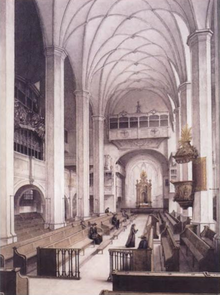|
Alles nur nach Gottes Willen, BWV 72
Alles nur nach Gottes Willen (Everything according to God's will alone),[1] BWV 72, is a church cantata by Johann Sebastian Bach. He composed it in Leipzig in 1726 for the third Sunday after Epiphany and first performed it on 27 January 1726. Bach used the opening chorus for the Gloria of his Missa in G minor, BWV 235. History and textBach composed Alles nur nach Gottes Willen in his third cantata cycle for the Third Sunday after Epiphany.[2][3] The prescribed readings for the Sunday were taken from the Epistle to the Romans, rules for life (Romans 12:17–21), and from the Gospel of Matthew, the healing of a leper (Matthew 8:1–13). The cantata text was written by Salomon Franck, who was Bach's librettist when they both worked for the ducal court in Weimar. Franck published it in Evangelisches Andachts-Opffer in 1715,[2] whereas Bach composed the music much later. Ihr, die ihr euch von Christo nennet, BWV 164, is a comparable example of Bach turning to a text by Franck late.[4] The closing chorale "Was mein Gott will, das g'scheh allzeit" was written by Albert, Duke of Prussia in 1547.[2] The chorale theme (Zahn 7568) by Claudin de Sermisy first appeared in print in the collection of secular songs Trente et quatre chansons in 1528. Bach had used the chorale before as the base for his chorale cantata Was mein Gott will, das g'scheh allzeit, BWV 111, composed for the same occasion in 1725.[5] Bach led the first performance of the cantata on 27 January 1726.[2][6] He later used the opening chorus for the Gloria of his Missa in G minor, BWV 235.[2][7] MusicScoring and structureBach structured the cantata in six movements. Bach scored the work for three vocal soloists (soprano (S), alto (A) and bass (B)), a four-part choir, and a Baroque instrumental ensemble of two oboes (Ob), two violins (Vl), two obbligato violins (Vs), viola (Va) and basso continuo.[2][8] The duration of the cantata is given as 20 minutes.[8] In the following table of the movements, the scoring follows the Neue Bach-Ausgabe. The keys and time signatures are taken from Alfred Dürr, using the symbol for common time (4/4).[2][9] The continuo, playing throughout, is not shown.
MovementsAlthough Franck had marked the first movement as an aria, Bach composed it as a chorus, opened by a ritornello dominated by runs of two measures in the violins, finally also in the continuo. The voices pick up the runs on the word "alles" (all), soprano first, and imitate each other one measure after the other, resulting in a complex image of "all". A rather quiet middle section on the words "Gottes Wille soll mich stillen" (God's will shall calm me)[1] in canonic imitation is accompanied by the orchestra, the following words "bei Gewölk und Sonnenschein" (among clouds or sunshine)[1] are illustrated by runs as in the beginning, but starting in a low range by the bass. The first and last section end with the choir embedded in the ritornello.[10] In his arrangement for the Gloria of the Missa, Bach dropped the first ritornello, adapted the words "Gloria in excelsis Deo" to the first section, "Et in terra pax" to the middle section, and "Laudamus te" to the last section.[10] The first recitative begins as a secco, but develops to an arioso on the words "Herr, so du willt" (Lord, as you will),[1] which are repeated nine times with a different continuo line, culminating in "so sterb ich nicht" (I will not die)[1] the following line is again secco.[10] The following aria begins immediately with the voice, to ensure a connection between recitative and aria, then follows an unusual ritornello, a fugue with the two violins and the continuo.[11] In the second aria, more like a song and dance, the instruments play a ritornello and repeat it after a short sung passage: "Mein Jesus will es tun, er will dein Kreuz versüßen" (My Jesus will do it, He will sweeten Your cross).[1] In the following main section the voice is embedded in the ritornello. The words of the middle section "Obgleich dein Herze liegt in viel Bekümmernissen" (Although your heart lies in many troubles)[1] are sung in the minor mode. After the following ritornello the soloist repeats once more as a final statement, "mein Jesus will es tun!" (my Jesus will do it!).[1][12] The closing chorale is a four-part setting.[12] Recordings
References
Cited sourcesBach Digital
Books
Online sources
External links
|
|||||||||||||||||||||||||||||||||||||||||||||||||||||||||||||||||||||||||||||||||||||||||
